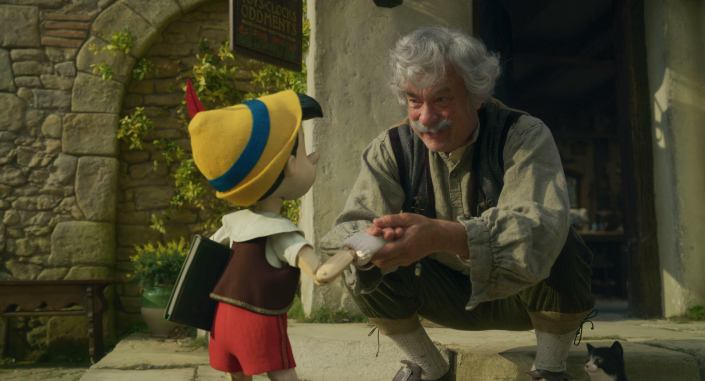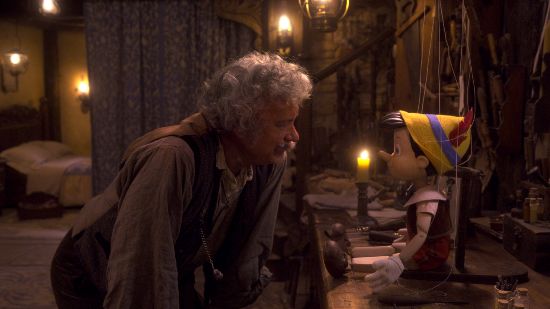Let Pinocchio Be the End of Disney’s Lazy CGI Remakes
Animation is supposed to bring things to life, not make them look dead-eyed.

It’s difficult to know how much withering denunciation is too much when discussing Pinocchio. Not the magical 1940 work of animation that was Disney’s sophomore effort after Snow White, but the 2022 remake that pulls in a bunch of big-name talent and oppressively omnipresent CGI to no purpose I can figure out. I’ve mentioned before that it’s stupid to ask why a film gets made because the answer is to make money. Pinocchio makes me question even that wisdom. Sometimes, apparently, movies are made because they are on the 10-year-plan, or the studio bosses perhaps took a month off and returned to find principal photography and a week of post-production work already finished and didn’t have the heart to tell the director and actors that they hadn’t actually greenlit the thing.
Every decision about Pinocchio baffles, from its bad jokes to its new characters who add almost nothing to an ending so abrupt that it defies reason. I write about movies almost constantly, and did not know about this thing until a week before it debuted unceremoniously on Disney+ despite Tom Actual Hanks starring in it under director Robert Zemeckis. All of these things, stared at long enough, could drive me mad, and I’m sure they are going to be trod over by every last F- review Pinocchio is going to receive. So, as I have so often before, I want to talk about what it means for animation, that peculiar magic that is an illusion of life, as Disney themselves have called it.
Pinocchio simultaneously drips with effort—every scene marked by computer-generated actors and effects—and a complete dearth of creativity. It actively resists being written about. And yet, it deals in one of the stories that is most emblematic of Disney’s art form, and most thematically resonant with it. To “animate” is to impart movement to the nonliving, which is not just the key to the medium Disney’s animators were pioneering at the time of the original film, but also happens to be the actual text of the film (spoilers)! There is a reason that “When You Wish Upon a Star” has been the score behind Disney’s studio logo for decades. It is a film, and a story, that is core to what Disney is.
Am I talking too melodramatically about a slap-dash cash-in movie about a puppet boy? Probably.
The era of Disney’s corporate leadership under former CEO Michael Eisner is often referred to as a “renaissance,” and it isn’t entirely unfounded: The company was losing at the box office to one of its own former animators, but ended the ’80s with the success story that has defined its releases pretty much ever since. It also kicked off a spectacular era in TV animation under the company’s banner.
But kids of the ’90s will recall that not everything the company did had lofty artistic merit, nor did every project they touched turn to gold. While their lower-budget animation house, Disney MovieToons, was responsible for one of the most affecting films I’ve ever seen from the Mouse House, it otherwise almost exclusively made garbage. Much of that garbage was composed of direct-to-video sequels in the wake of Aladdin 2: The Return of Jafar’s success.
The animation standards for things like The Fox and the Hound 2 or Beauty and the Beast: The Enchanted Christmas being lower than the otherwise sterling Disney canon was less a problem than the pure mercenary attitude behind it all. Eisner has been quoted as saying, during those years, that Disney had “no obligation to make art,” or history or a statement, but that making money often meant making those other things. It seems the guy was right: Disney made money hand over fist during that period, climbed back to box office dominance with some of its most well-regarded films ever, before eventually largely abandoning the art of 2-D animation in favor of the 3-D revolution. Eisner is gone now, but Disney making art or history or a statement has never felt more incidental: For every Moana there is one more in the parade of live-action/CGI remakes of classic Disney films. More than a decade after he stepped down as CEO from the company, nothing seems more out of the Eisner playbook than these remakes.
-

-

-

-

-

-

-

-

-

-

-

-

-

-

-

-

-

-

-

-

-

-

-

-

-

-

-

-

-

-

-

-

-

-

-

-

-

-

-

-










































